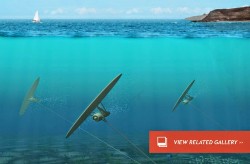It has been around for quite some time – the fact that one can generate electricity using kites and balloons, but can we really generate it with underwater kites rather than the prevalent turbulent currents?
There are some fascinating proposals already for power generation using tethered kites and balloons… Why not indeed, because that is exactly what two independent teams of researchers are doing, one from
Sweden and the other from Worcester Polytechnic Institute
USA [Source: Discovery News].
A Massachusetts research program just got a nice big grant from the National Science Foundation to work on harnessing ocean currents and tidal flows using underwater kites. The potential: Power equal to about 10 nuclear power plants.
This kite-flying dream is being led by David Olinger, an associate professor of mechanical engineering at Worcester Polytechnic Institute specializing in wind and wave turbines. In the past, he and his students developed a very inexpensive kite-powered water pump for developing nations. Now he’s looking to create small tethered, undersea kites that can “fly” quickly in currents. The NSF recently awarded Olinger’s new research program $300,000.
Olinger cited the Gulf Stream, the massive underwater current flowing from the Gulf of Mexico into the Atlantic Ocean. That power potential is estimated at about 20 gigawatts, or about 10 nuclear power plants. ”Just as wind turbines can convert moving air into electricity, there is the potential to transform these virtually untapped liquid ‘breezes’ into vast amounts of power”.
Olinger’s system has similarities to the underwater kites designed by the Swedish company Minesto. However, Minesto plans to tether the kites to the ocean floor while Olinger’s group would attach them to a floating system. Each Minesto’s kite also has a wind turbine attached while Olinger will look at potentially removing the turbine and placing the electrical generator on the floating platform instead.
Just as traditional kites use air currents to generate lift, underwater kites use water currents to generate hydrodynamic lift. The tethered motion of the underwater kite generates electricity as water flows through an attached ducted turbine.
Water currents tend to be much more reliable and predictable than air currents so the expectation is that using water currents to generate electricity should be a more dependable power source. Also, given that water is approximately 800 times denser than air, the underwater kites can be much more compact for a similar power output compared to airborne kites. On the downside, water tends to be a hostile environment for machinery (especially metals). Also water is a relatively good conductor, so extra precautions are necessary for transmitting electricity…


